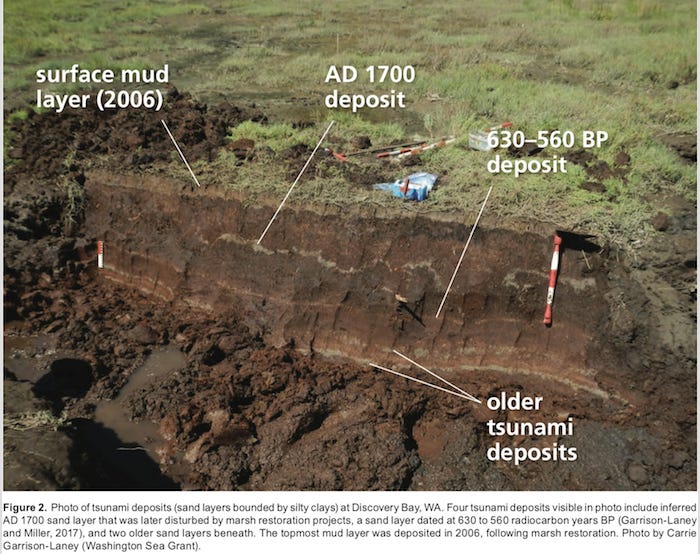Wow, this was a first. Getting a “Tsunami Advisory” on my phone. (It goes with my first ever “Tornado Advisory,” which I received on November 9.) Neither event played out but I still appreciate getting the information. I also know that it will not be the last tsunami warning I get.
Geologists, ethnographers, and archaeologists have found evidence for several tsunamis lashing down Puget Sound and the Strait of Juan de Fuca. The one with the best geological evidence, at least around Seattle, comes from an earthquake about 1,100 years ago on the Seattle Fault zone. Consisting of several separate faults that run from Lake Sammamish to Bainbridge Island roughly along the route of I-90, the crustal zone of weakness created the tsunami when its south side thrust up about 20 feet. This caused a displacement of water that led to waves spreading across the Sound, one of which deposited a Douglas fir and a layer of sand at West Point in Discovery Park.

Other tsunami deposits include one at the tip of Hood Canal, at Lynch Cove near, Belfair. In geologist Carrie Garrison-Laney’s PhD dissertation, she describes two layers of silt at Lynch Cove deposited by a tsunami generated by earthquakes off the Washington coast, the most recent of which occurred in January 26, 1700. This means that tsunamis can make a 90 degree turn at Admiralty Inlet and then turn again to enter Hood Canal. As my wife would say, physics did that.

Although the evidence is not clear cut, recent work by archaeologists suggests that when past tsunamis hit they affected the people living in the region. At Discovery Bay, it appears that one tsunami caused the temporary abandonment of a village. Movement of the Seattle Fault and the subsequent tsunami also caused abandonment of several village locations around the Sound and may have lead to the change of one site from a summer fishing and clamming camp to a major winter village. The fault is also associated with a’yahos, or a shape-shifting supernatural being connected with “shaking and rushes of turbid waters,” write the authors of a 2005 report.
For thousands of years, the active geologic nature of this place has permeated the collective psyche of the region, shaping how and where we live. My hunch is that modern residents are proud of and thrilled by the geology but they are also nervous about it. (My guess is that residents of earlier eras, particularly geologically dramatic ones, learned to adapt.) I don’t think residents would want it any other way because we recognize that our geology is what makes this such a beautiful place to live, even if it has the potential to kill and cause billions of dollars of damages.
The other outstanding feature of the Tongan eruption (which generated about a foot high wave in the Sound) is that the volcano produced an atmospheric ripple that traveled the globe at 820 mph and which temporarily blew away the fog in Seattle. I just have to say “Holy Guacamole. That is totally amazing.” As they say, it's a small, round planet we inhabit.
References:
Hutchinson, I., “Geoarchaeological Perspectives on the “Millennial Series” of Earthquakes in the Southern Puget Lowland, Washington, USA,” Radiocarbon 57, No. 5, 2015, 917-941.
Ludwin, R.S. et al, “Dating the 1700 Cascadia Earthquake: Great Coastal Earthquake in Native Stories,” Seismological Research Letters 76, No. 2, March/April 2005, 140-148.
Ludwin, R.S. et al, “Serpent Spirit-power Stories Along the Seattle Fault, Seismological Research Letters 76, No. 4, July/Aug 2005, 426-431.
Thanks again to all who have signed up as paid subscribers. It has been such a pleasant surprise to get your kind comments about my work. I look forward to sharing more stories through my newsletter. Again, don’t be shy about suggesting ideas.






In case you haven't seen it this is a very neat book - https://www.flickr.com/photos/wanderflechten/8632781703/
I like the comment that residents would not want it any other way, we love the geology in spite of the potential dangers it can bring. I am fascinated (and was not aware of) the atmospheric waves that circled the globe in two directions. The world, including the PNW, continues to fascinate me!